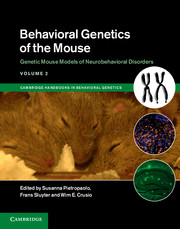35 results
Series page
-
- Book:
- Behavioral Genetics of the Mouse
- Published online:
- 05 October 2014
- Print publication:
- 25 September 2014, pp ii-ii
-
- Chapter
- Export citation
Contents
-
- Book:
- Behavioral Genetics of the Mouse
- Published online:
- 05 October 2014
- Print publication:
- 25 September 2014, pp vii-viii
-
- Chapter
- Export citation
Section 7 - Neurodegenerative disorders
-
- Book:
- Behavioral Genetics of the Mouse
- Published online:
- 05 October 2014
- Print publication:
- 25 September 2014, pp 391-446
-
- Chapter
- Export citation
Contributors
-
-
- Book:
- Behavioral Genetics of the Mouse
- Published online:
- 05 October 2014
- Print publication:
- 25 September 2014, pp ix-xii
-
- Chapter
- Export citation
Section 4 - Social dysfunction and mental retardation
-
- Book:
- Behavioral Genetics of the Mouse
- Published online:
- 05 October 2014
- Print publication:
- 25 September 2014, pp 86-239
-
- Chapter
- Export citation
10 - Pathological aggression
- from Section 4 - Social dysfunction and mental retardation
-
-
- Book:
- Behavioral Genetics of the Mouse
- Published online:
- 05 October 2014
- Print publication:
- 25 September 2014, pp 86-96
-
- Chapter
- Export citation
Section 3 - Autonomous and motor disorders
-
- Book:
- Behavioral Genetics of the Mouse
- Published online:
- 05 October 2014
- Print publication:
- 25 September 2014, pp 35-85
-
- Chapter
- Export citation
Dedication
-
- Book:
- Behavioral Genetics of the Mouse
- Published online:
- 05 October 2014
- Print publication:
- 25 September 2014, pp v-vi
-
- Chapter
- Export citation
Section 6 - Substance dependence and abuse
-
- Book:
- Behavioral Genetics of the Mouse
- Published online:
- 05 October 2014
- Print publication:
- 25 September 2014, pp 293-390
-
- Chapter
- Export citation
Index
-
- Book:
- Behavioral Genetics of the Mouse
- Published online:
- 05 October 2014
- Print publication:
- 25 September 2014, pp 447-457
-
- Chapter
- Export citation
1 - Introduction
- from Section 1 - Introduction to genetic mouse models of neurobehavioral disorders
-
-
- Book:
- Behavioral Genetics of the Mouse
- Published online:
- 05 October 2014
- Print publication:
- 25 September 2014, pp 1-3
-
- Chapter
- Export citation
Section 1 - Introduction to genetic mouse models of neurobehavioral disorders
-
- Book:
- Behavioral Genetics of the Mouse
- Published online:
- 05 October 2014
- Print publication:
- 25 September 2014, pp 1-17
-
- Chapter
- Export citation

Behavioral Genetics of the Mouse
-
- Published online:
- 05 October 2014
- Print publication:
- 25 September 2014
Copyright page
-
- Book:
- Behavioral Genetics of the Mouse
- Published online:
- 05 October 2014
- Print publication:
- 25 September 2014, pp iv-iv
-
- Chapter
- Export citation
Behavioral Genetics of the Mouse Volume II - Title page
-
-
- Book:
- Behavioral Genetics of the Mouse
- Published online:
- 05 October 2014
- Print publication:
- 25 September 2014, pp iii-iii
-
- Chapter
- Export citation
Behavioral Genetics of the Mouse Volume II - Half title page
-
- Book:
- Behavioral Genetics of the Mouse
- Published online:
- 05 October 2014
- Print publication:
- 25 September 2014, pp i-i
-
- Chapter
- Export citation
Section 5 - Anxiety and mood disorders
-
- Book:
- Behavioral Genetics of the Mouse
- Published online:
- 05 October 2014
- Print publication:
- 25 September 2014, pp 240-292
-
- Chapter
- Export citation
Section 2 - Perception disorders
-
- Book:
- Behavioral Genetics of the Mouse
- Published online:
- 05 October 2014
- Print publication:
- 25 September 2014, pp 18-34
-
- Chapter
- Export citation
Behavioral Genetics of the Mouse - Title page
-
-
- Book:
- Behavioral Genetics of the Mouse
- Published online:
- 05 May 2013
- Print publication:
- 25 April 2013, pp iii-iii
-
- Chapter
- Export citation
Section 2 - Perception
-
- Book:
- Behavioral Genetics of the Mouse
- Published online:
- 05 May 2013
- Print publication:
- 25 April 2013, pp 36-80
-
- Chapter
- Export citation



